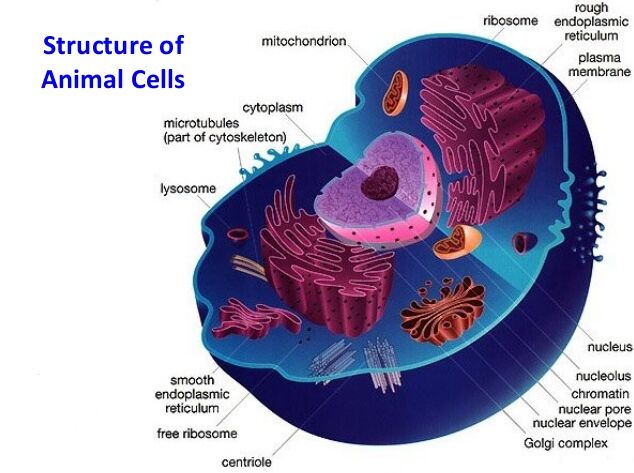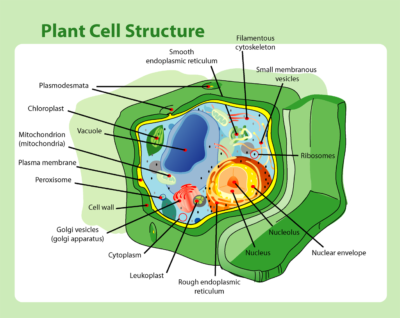Cell Structure: Subcellular Components Study Guide
Introduction:
The eukaryotic cell is divided into several subcellular components, each with its environment and specific function. It is essential that all of these subcellular components of the cell function properly to keep the cell and the organism alive. As it will be seen, all the components have their discrete environments with different concentrations of molecules and physical characteristics that allow them to carry out their function.
The cell structure: subcellular components
The eukaryotic cell is composed of different components with specialized functions. The diagram below shows the anatomy of a cell and the subcellular structure:
Here are some of the main subcellular components of cell:
1. Mitochondria
- Mitochondria are important subcellular structures that make energy available to the cells. Their DNA is important in the endosymbiotic theory.
- They convert glucose into ATP (adenosine triphosphate) by the process of cellular respiration.
- This is then transported around the cell as a source of energy.
- A typical eukaryotic cell has about 2000 of these ellipsochlorophyll moleculesidal-shaped organelles.
- Their outer membrane is smooth, while the inner membrane is highly convoluted with invaginations called cristae.
- The cristae contain all the membrane-bound enzymes needed for the electron-transport chain.
2. Lysosomes
- Lysosomes are membrane-enclosed sacs that contain enzymes for the degradation of proteins, lipids, polysaccharides, and nucleic acid.
- The inside of the lysosome is extremely acidic (pH about 5) and helps recycle and digest old or damaged parts of the cell. They also help in the process called programmed cell death, or apoptosis.
3. Endoplasmic Reticulum
- The endoplasmic reticulum (ER) is a subcellular structure responsible for producing and transporting proteins and lipids.
- The ER can be divided into the rough endoplasmic reticulum (RER) and smooth endoplasmic reticulum (SER).
- The RER is studded with ribosomes while the smooth has none, giving them their distinct appearance.
4. Golgi apparatus
- The Golgi apparatus is made of stacks of flattened membrane sacs.
- Its main function is to process proteins to prepare them both inside and outside the cell, and they are also involved in the transport of lipids.
5. Vacuole
- The central vacuole helps the plant cells stay rigid and contains water, salts, and enzymes.
- The central vacuole can take up as much as 90% of the cell’s volume.
- The contractile vacuole in unicellular organisms, particularly protozoa and certain unicellular algae, helps regulate the quantity of water inside a cell and may excrete nitrogenous wastes too.
6. Chloroplasts:
- These plastics contain the green pigment chlorophyll that gives leaves their distinct color.
- These organelles have two membranes: an outer membrane and an inner membrane. The stacked, disc-shaped structures are called thylakoids, and molecules of chlorophyll are embedded in the thylakoid membrane.
- They help capture sunlight for photosynthesis.
- The photosynthetic process utilizes light energy to synthesize organic compounds from carbon dioxide.
Conclusion:
The subcellular components of the cell have specific functions that support the survival of the cell.
FAQs:
1. What is the subcellular structure?
The subcellular structures can be organelles, specific regions in the cells with distinct physical or chemical concentrations, or cell structures with a particular task.
2. What is an example of a subcellular structure?
The mitochondria are an example of a subcellular structure. The mitochondria convert glucose into ATP used up by the cells as an energy source.
3. What are subcellular compartments?
The subcellular components include the nucleus, endoplasmic reticulum, ribosome, Golgi apparatus, and mitochondria.
4. What are two subcellular components necessary for all cells?
All cells must have a nucleus and mitochondria.
5. What is the difference between subcellular and cellular?The word cellular refers to processes that occur at the cell levels or multiple cells, while subcellular refers to processes that occur within the cell.
6. Which subcellular structures can be found in an animal cell?
Animal cells contain cell membrane, cytoplasm, cytoskeleton, Nucleus, centrioles, lysosomes, endoplasmic reticulum, ribosomes, Golgi apparatus, and mitochondria.
7. What are the subcellular organelles of the nucleus?
The cell nucleus contains:
- Nuclear envelope
- Nucleoplasm
- Nucleus sap
- Nuclear matrix
- Chromatin
- nucleolus
8. Which part functions the photosynthetic activities of a plant cell?
The chloroplasts which contain chlorophyll is the part where photosynthesis takes place.
We hope you enjoyed studying this lesson and learned something cool about the Cell Structure: Subcellular Components! Join our Discord community to get any questions you may have answered and to engage with other students just like you! Don’t forget to download our App and check out our awesome VR room for this guide – we promise, it makes studying much more fun 😎
Sources:
- AP biology cell structure https://apcentral.collegeboard.org/pdf/ap-biology-course-and-exam-description-0.pdf?course=ap-biology Accessed 30 Dec, 2021.
- Subcellular compartments https://www.nature.com/scitable/topic/subcellular-compartments-14122679/ Accessed 30 Dec, 2021.
- Cell structure https://www.ck12.org/book/ck-12-biology-advanced-concepts/section/3.9/ Accessed 30 Dec, 2021.


